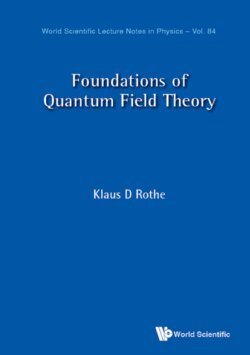Читать книгу Foundations of Quantum Field Theory - Klaus D Rothe - Страница 23
На сайте Литреса книга снята с продажи.
3.4KG equation in the presence of an electromagnetic field
ОглавлениеThe interaction of a charge q with an external electromagnetic field is introduced in the Klein–Gordon equation by the usual minimal substitution
where Aμ = (Φ, ) is related to the electric field E in the usual way:
This leads us to consider the equation of motion
with the covariant derivative
It is important to realize that unlike the free particle case, this equation can no longer be factorized in the form (3.7):
where H is the Hamiltonian for a relativistic particle moving in an external electromagnetic field:
Eq. (3.11) is covariant under the following gauge transformation
where Λ(x) denotes an arbitrary function of x. Indeed, under this transformation
or equivalently
In particular
Hence defining the gauge-transformed wave function ϕ′(x) by
Eq. (3.14) implies
The transformation law (3.15) can be restated in the following way: The wave function ϕ(x) is a functional of the vector potential Aμ(x):
The transformation law (3.15) for the covariant derivative then implies that under the gauge transformation (3.13) the functional ϕ(x; Aμ) transforms as follows:
The gauge covariance of the equation of motion (3.11) allows us to choose in particular the covariant Lorentz gauge ∂·A = 0. In this gauge the 4-tuplet Aμ = (A0, ) transforms like a 4-vector. This demonstrates the manifest Lorentz covariance of the equation of motion (3.16) in the Lorentz gauge.
